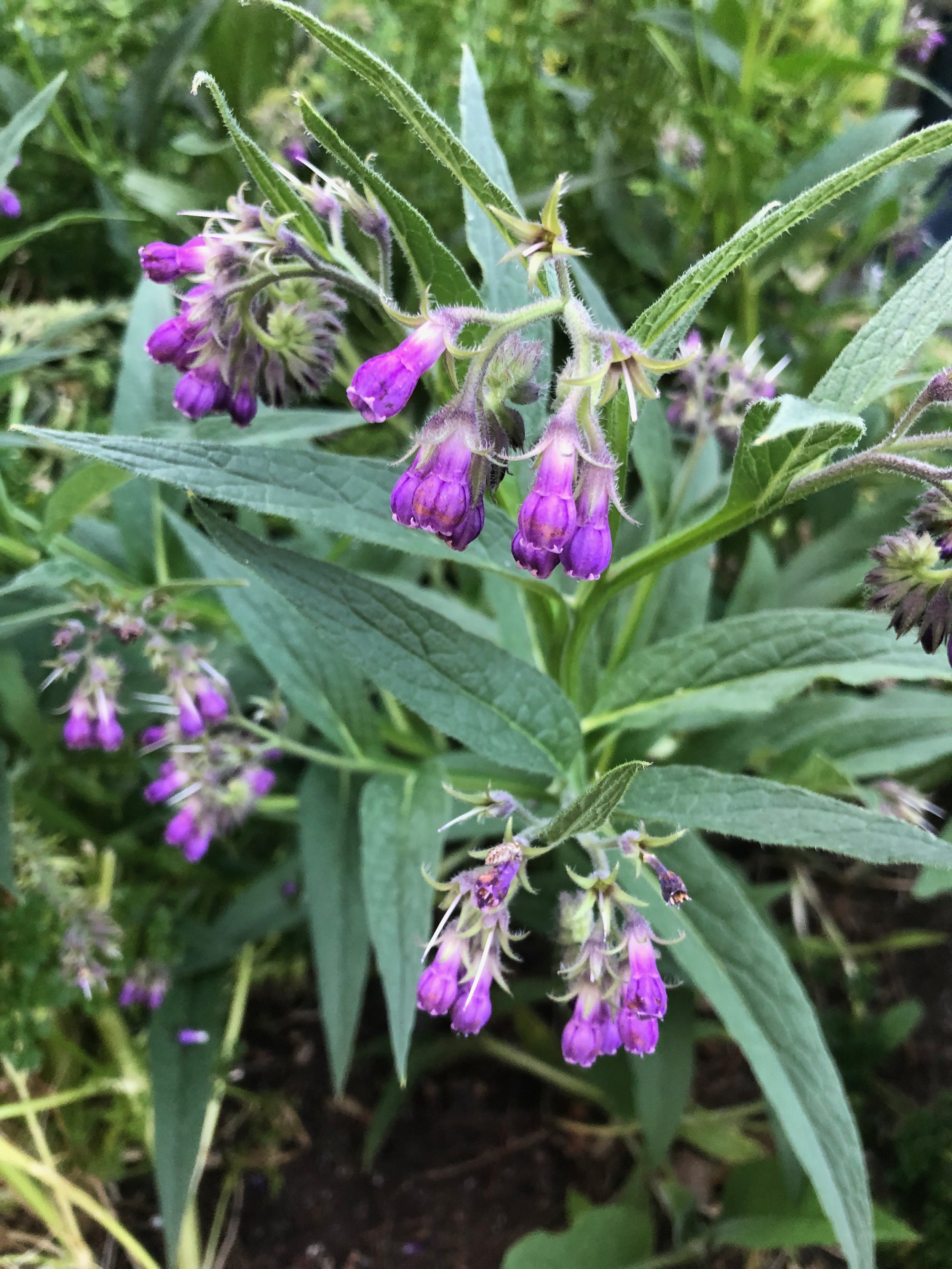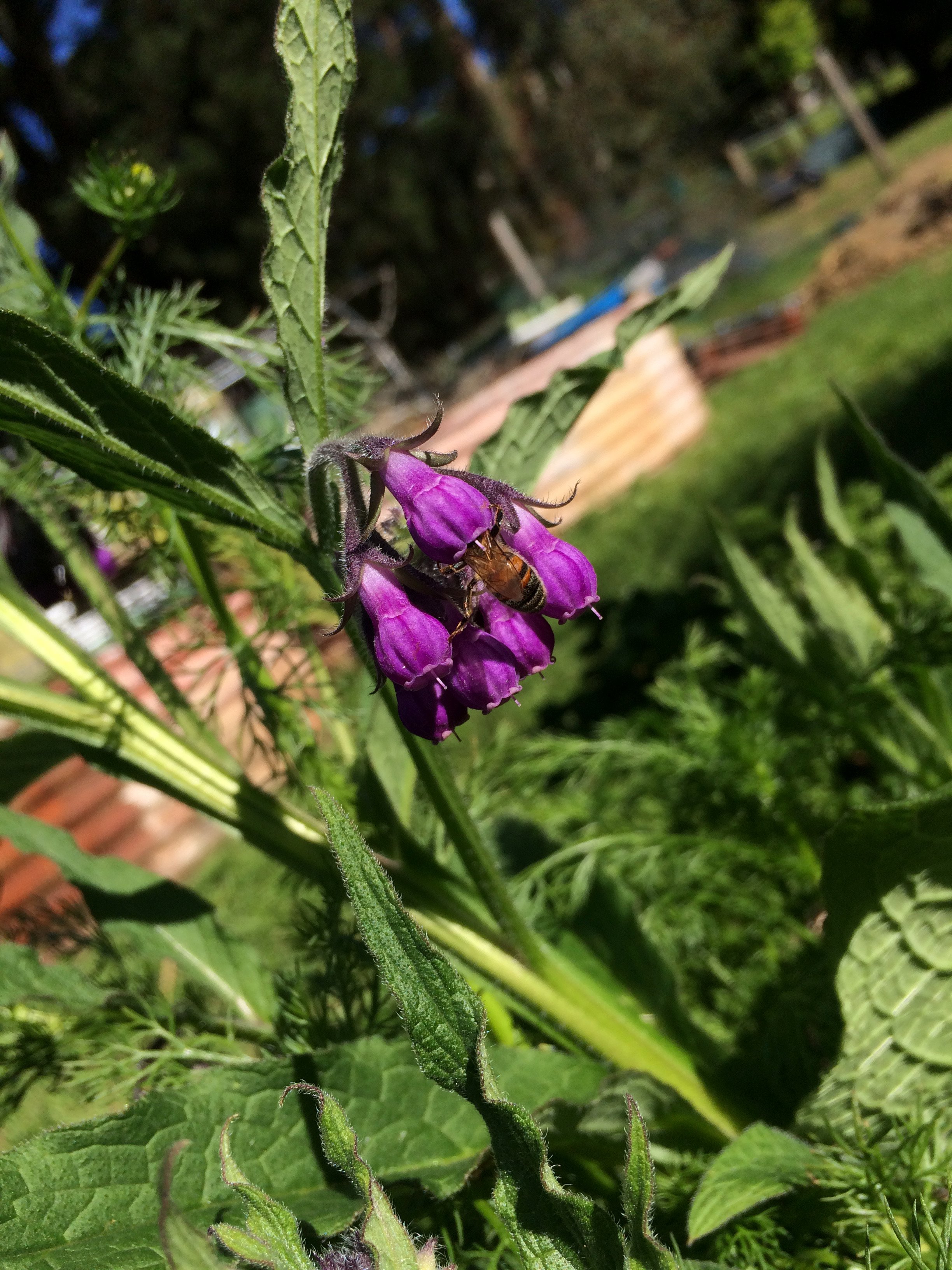 Image 1 of 4
Image 1 of 4

 Image 2 of 4
Image 2 of 4

 Image 3 of 4
Image 3 of 4

 Image 4 of 4
Image 4 of 4





Comfrey Seeds
Comfrey (Symphytum officinalis)
Description:
Comfrey is a perennial herb that belongs to the Boraginaceae family. It is renowned for its rapid growth, attractive foliage, various uses in the garden, and traditional medicinal uses. Comfrey is robust and forms clumps of large, hairy, lance-shaped leaves that can grow up to 1 to 3 feet (30 to 90 cm) in length. They have a rough texture and are typically a vibrant green colour. Comfrey produces bell-shaped flowers that can range in colour from creamy white to pink or purple, depending on the variety (this seed variety is purple). The flowers are borne on sturdy stems and are attractive to pollinators like bees. The roots of Comfrey are deep and fleshy, aiding in its ability to gather nutrients from the soil.
Comfrey will spread throughout the garden relatively rapidly. To avoid spreading, cut them back when they have started flowering (early phase), using the cut stems and leaves for mulch or compost.
Growing Conditions:
Climate: cool-temperate; prefers mild summers and cool winters.
Position: tolerates a wide range of light conditions but prefers partial shade with dappled sunlight or areas that receive 4 to 6 hours of direct sunlight per day.
Soil: fertile, sandy, loamy and well-draining soil but can tolerate various soil types; thrives in slightly acidic to neutral pH range (around 6.0 to 7.0). It is known for its ability to accumulate nutrients, so it benefits from nutrient-rich soil.
Water: moderate water needs; water the plant regularly to keep the soil evenly moist but avoid waterlogging. Once established, Comfrey can tolerate some drought.
Spacing: space the plants approximately 2 to 3 feet (60 to 90 cm) apart to allow them room to spread.
Propagation: typically propagated from root cuttings or crown divisions in the spring or autumn; when propagating from seed, sow directly into warm soil (germination may take up to a month) or provide 30 days cold stratification prior to sowing into warm soil to speed up germination.
Harvest: leaves when the plant is in its prime growth stage, typically during late spring or early summer.
20 seeds per pack
Comfrey (Symphytum officinalis)
Description:
Comfrey is a perennial herb that belongs to the Boraginaceae family. It is renowned for its rapid growth, attractive foliage, various uses in the garden, and traditional medicinal uses. Comfrey is robust and forms clumps of large, hairy, lance-shaped leaves that can grow up to 1 to 3 feet (30 to 90 cm) in length. They have a rough texture and are typically a vibrant green colour. Comfrey produces bell-shaped flowers that can range in colour from creamy white to pink or purple, depending on the variety (this seed variety is purple). The flowers are borne on sturdy stems and are attractive to pollinators like bees. The roots of Comfrey are deep and fleshy, aiding in its ability to gather nutrients from the soil.
Comfrey will spread throughout the garden relatively rapidly. To avoid spreading, cut them back when they have started flowering (early phase), using the cut stems and leaves for mulch or compost.
Growing Conditions:
Climate: cool-temperate; prefers mild summers and cool winters.
Position: tolerates a wide range of light conditions but prefers partial shade with dappled sunlight or areas that receive 4 to 6 hours of direct sunlight per day.
Soil: fertile, sandy, loamy and well-draining soil but can tolerate various soil types; thrives in slightly acidic to neutral pH range (around 6.0 to 7.0). It is known for its ability to accumulate nutrients, so it benefits from nutrient-rich soil.
Water: moderate water needs; water the plant regularly to keep the soil evenly moist but avoid waterlogging. Once established, Comfrey can tolerate some drought.
Spacing: space the plants approximately 2 to 3 feet (60 to 90 cm) apart to allow them room to spread.
Propagation: typically propagated from root cuttings or crown divisions in the spring or autumn; when propagating from seed, sow directly into warm soil (germination may take up to a month) or provide 30 days cold stratification prior to sowing into warm soil to speed up germination.
Harvest: leaves when the plant is in its prime growth stage, typically during late spring or early summer.
20 seeds per pack
Comfrey (Symphytum officinalis)
Description:
Comfrey is a perennial herb that belongs to the Boraginaceae family. It is renowned for its rapid growth, attractive foliage, various uses in the garden, and traditional medicinal uses. Comfrey is robust and forms clumps of large, hairy, lance-shaped leaves that can grow up to 1 to 3 feet (30 to 90 cm) in length. They have a rough texture and are typically a vibrant green colour. Comfrey produces bell-shaped flowers that can range in colour from creamy white to pink or purple, depending on the variety (this seed variety is purple). The flowers are borne on sturdy stems and are attractive to pollinators like bees. The roots of Comfrey are deep and fleshy, aiding in its ability to gather nutrients from the soil.
Comfrey will spread throughout the garden relatively rapidly. To avoid spreading, cut them back when they have started flowering (early phase), using the cut stems and leaves for mulch or compost.
Growing Conditions:
Climate: cool-temperate; prefers mild summers and cool winters.
Position: tolerates a wide range of light conditions but prefers partial shade with dappled sunlight or areas that receive 4 to 6 hours of direct sunlight per day.
Soil: fertile, sandy, loamy and well-draining soil but can tolerate various soil types; thrives in slightly acidic to neutral pH range (around 6.0 to 7.0). It is known for its ability to accumulate nutrients, so it benefits from nutrient-rich soil.
Water: moderate water needs; water the plant regularly to keep the soil evenly moist but avoid waterlogging. Once established, Comfrey can tolerate some drought.
Spacing: space the plants approximately 2 to 3 feet (60 to 90 cm) apart to allow them room to spread.
Propagation: typically propagated from root cuttings or crown divisions in the spring or autumn; when propagating from seed, sow directly into warm soil (germination may take up to a month) or provide 30 days cold stratification prior to sowing into warm soil to speed up germination.
Harvest: leaves when the plant is in its prime growth stage, typically during late spring or early summer.
20 seeds per pack